|
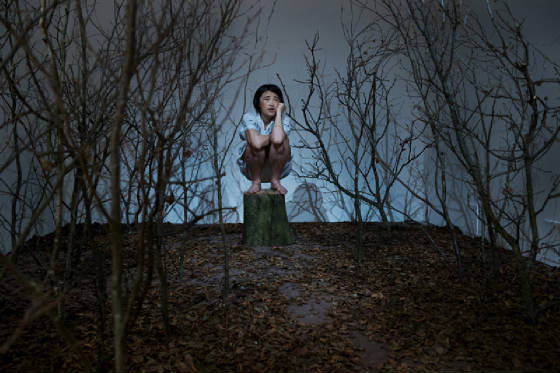
|
| YINGMEI DUAN, Happy Yingmei (2011,2012) Photo Linda Nylind |
Art of Change: New
Directions from China
Hayward Gallery, London
By Anna Leung
That
direction and dissent play a prominent role in this exhibition should not come
as a surprise given the meteoric and dramatic pace of change, on all levels, that
is overtaking China. However, appending ‘New Directions’ to ‘Art of Change’ seems
somewhat of a misnomer since there is absolutely no unanimity about what direction/s
such a transformation should take. At first sight the title, and by extension
the exhibition, seem to refer to a modernist/post-modernist discourse and its
relation to an absence of or adherence to tradition, a position which in itself
reflects a Euro-ethnic influence. But the situation is far more complex due to the
legacy of the Cultural Revolution which over a ten year period of repression precipitated
a complete caesura with the past, leaving the next generation of young artists
groping in the dark unable to make contact with past traditions or with what
was happening in the West. Since 1978 and Deng Xiaoping’s policies of reform
that encouraged a flow of ideas from the West there had been a radical
rethinking of modern art practices and an attempt to create a three way relationship
between western post modernism, globalism and a Chinese tradition. But the 1989 Tiananmen Square massacres
brought with it another clamp down that resulted in much innovative or
experimental art that may well have been interpreted as a critique of the
totalitarian state, being banned or facing severe restrictions. As a result
‘xingwei-zhuanzhi’ i.e. performance and installation art practices that had no
stylistic components and could, if necessary, be rapidly dismantled have gained
ground in an art market which, while being one of the most rapidly growing
sectors in the world, lacks critics and the backing of established art
practices. Added to this is the impact of the post modernist critique of
originality which justified the notion of the scavenger artist rearranging
prefabricated ideas, images and ready made objects which became main stream in
the West from the end of the 80’s at the very moment when the art from
marginalised cultures, including China, began to gain international recognition.
All this makes for problems especially for us in the West but probably also for
the Chinese in judging or evaluating this body of work.
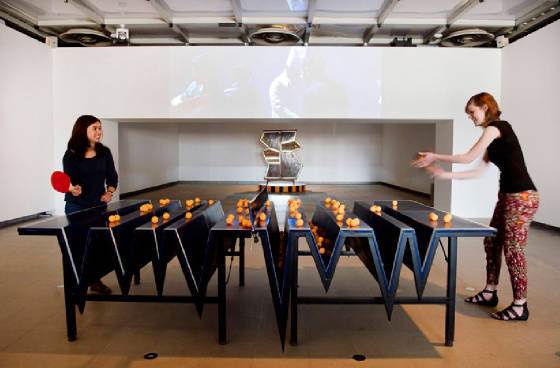
|
| WANG JIANWEI, Surplus Value (2010) Photo Linda Nylind |
One way to overcome
these problems is through context and the Hayward Gallery has attempted to make good this lack by providing an interactive
archive relating the various art practices to the nexus of socio-political events that gave rise to them. However comprehensive
this may be it takes time and attention to follow through. Moreover it seems at variance with the spontaneity and immediacy
that characterise most of the art work. Another approach in an attempt to understand what motivates contemporary Chinese artists
is to look to their traditions and Chinese belief systems and to ask whether they remain relevant. Taoism with its emphasis
on change and continual flux immediately comes to mind as to a lesser extent does Chan Buddhism. Fundamental to Taoist teachings
are the observation of nature’s cyclic patterns and the interaction of yin and yang as polar opposites within the undifferentiated
Tao, the source of all being. Such ideas remain operative though not necessarily explicitly so in this exhibition. However
a polarisation of sorts is characteristic of the exhibition as a whole with art works oscillating between a kind of sweetness
and a poetics of purity that involves a search for harmony as opposed to others that exploit brutality, calculated disturbance
and the use of extreme shock. Nine artists have been chosen to represent the new directions within Chinese art. Their work
covers a period of thirty years and explores the central idea of impermanence and change.
Liang Shaoji is the oldest within this
grouping. Born in 1945 he is the closest to his Chinese roots. Exiled to the countryside during Mao’s Great Leap Forward
(1958-61) he eventually graduated in textiles and worked as a designer during the Cultural Revolution but was prevented from
setting up as an independent artist till he was in his forties. Central to his art practice is the notion of metamorphosis
symbolised by the different stages of the silk worm’s life cycle. At the centre of his Nature Series is a darkened room
that houses cohorts of silkworms munching their way through mulberry leaves which we can hear through the headphones provided.
Liang Shaoji suggests that listening to the silkworms is an experience akin to listening to zen. It is also a very Taoist
response for a Taoist elects to live in accord with nature, contemplating nature’s ways and letting things be by respecting
the concept of Wu Wei, i.e. only doing what is needed and no more. Liang Shaoji’s living sculptures embody this attitude
as his basic structures made up of lattice casement windows, wire cots and heavy metal chains are very gradually transformed,
not through his efforts, but naturally through the silkworms’ life work into something mysterious and poetic which the
artist hopes will foster our sense of inner peace.
Happy Yingmei is a performance that suffuses a tender almost fairytale sweetness
and is loosely based on the Oscar Wilde’s story ‘The Happy Prince’. To reach this installation and performance
we have to crawl through a small opening that leads to a dimly lit space suggestive of a forest glade. The German based artist
Yingmei Shaoji who studied with Marina Abramovic crouches at the back softly singing to herself. Eventually she approaches
her visitors and then with a smile hands out folded instructions to them some of which are doable within the context of the
exhibition, others not. More socially inclined works by the same artist include Sleeping, In Between and Patience, all of
which are concerned with the way the mind can break free of our material conditions.
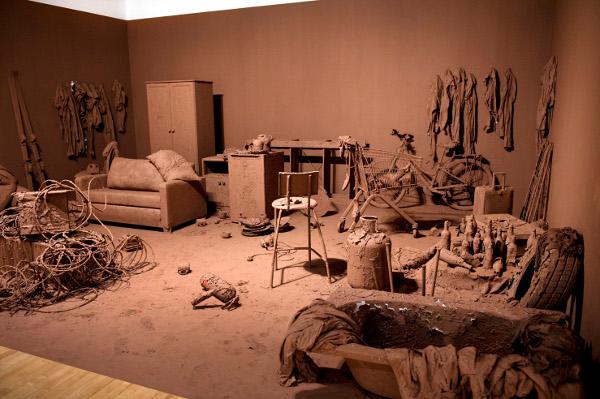
|
| CHEN ZHEN, Purification Room (2000-2012) ©The Artist 2012. Photo: Linda Nylind. |
Chen Zhen who
was born in 1958 took as his main concern the interrelation between the mind
and body. Having been diagnosed with a rare auto-immune blood disorder and told
he had only a few years to live he decided to immigrate to France but before
doing so spent six months at a Tibetan Buddhist temple. He was trained as a painter but on reaching
Europe came under the influence of Joseph Beuys and began to make mixed media
installations. Believing also in using art for therapeutic purposes, his main
concern was to explore the path of Buddhist spirituality, find common ground
between East and West and achieve harmony through difference using medicine and
the human body as metaphors on one hand and his Chinese roots and western aesthetics
on the other. In his main contribution to this exhibition, Purification Room (2000/2012) natural material, in this
case mud,
is used to purify and unify isolated throw away objects that exemplify our consumer
culture. Chen Zhen died in 2000 having achieved international recognition.
At the
other end of the scale is the collaboration between Sun Yuan and Peng Yu whose Old People’s Home featured in the first exhibition of Chinese
contemporary art at the new Saatchi Gallery in 2008. Notorious for the
brutality of their vision – in 2001 the Chinese Department of Cultural Affairs
prohibited their performances that were deemed bloody, obscene and violent - it
can be argued, by way of a defence, that their provocative performances and
videos which use extremes of violence to confront the violence endemic in
society are intended to act homoeopathically, like with like, and awaken the
public to the dehumanising effects of the state system and its links with
capitalism and globalisation. Their work
often seems plain nasty and not thereby necessarily ethically redeemable. However,
using body parts from mortuaries, live animals and the animal carcasses they
have as their aim to force us to reconsider our place in a material world and consider
our parity with animals – are we that much different or necessarily superior?.
Live animals are often used as art material, e.g. the video Dogs that cannot Touch Each Other 2003
which feature pit ball terriers that, facing each other on treadmills, run non
stop - though not without statutory breaks - without ever getting any nearer to
their rival, whereas in Safe Island
it is the humans in their enclosure who are stalked by the tiger prowling outside.
Add to that their Civilisation Pillar
2001 made up of fat siphoned from cosmetic liposuction surgery designed to make
us ponder on the depths of human vanity.
Xu Zhen is the
youngest of this group of artists. His video The Starving of Sudan 2008 considers the degree of culpability
involved in creating newsworthy footage. Xu Zhen’s intention is to force the
viewer to reflect on the type of ethical dilemma that routinely faces a camera
man in a war zone or famine stricken country such as Sudan. But with the dying
African child replaced by a chubby toddler in nappies who is repeatedly coaxed
by his or her mother to take on the stance of the original child and the
vulture being a stuffed vulture I think this exercise, however worthy its aim, fails
to convince. Xu Zhen is also responsible for
Just a Blink of an Eye that features what seems to be an impossible real
life falling figure, said by some critics to have a political agenda, and Untitled the remotely controlled fitness
machines at the entrance of the exhibition that has definite ironic undertones. In 2009 taking on a de-authoring stance
he
morphed into MadeIn a creative
corporation that has as it main target the foibles of the art market and the
commodification of art that has so dramatically overtaken the Chinese art world
these last few years.
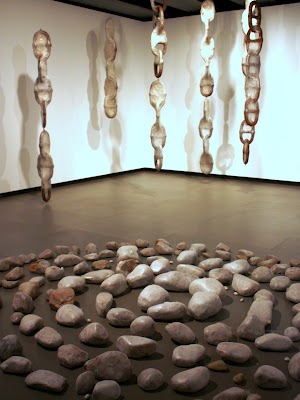
|
| LIANG SHAOJI, Nature Series, Hayward Gallery |
Ai We Wei
is notable for his absence from this exhibition but has been extremely critical
of it. Writing in the Guardian newspaper he compared the exhibition to a
Chinese restaurant that ‘sells all the standard dishes, such as kung pao
chicken and sweet and sour pork’ adding that ‘people will eat it and say how it
is Chinese but it is simply a consumerist offering, providing little in the way
of a genuine experience of life in China today.’ While not directly attacking any of the nine
artists Ai Wei Wei condemns the exhibition ‘as part of a propagandist cultural
exchange’ whose only purpose is ‘to charm viewers with its ambiguity.’ To his
mind it fails because it failed to address ‘a single one of the country’s most
pressing contemporary issues.’ Is Ai Wei Wei suggesting that these artists, by
not creating explicitly political art, are complicit with the state’s suppression
of freedom of expression and consequently, even if indirectly, endorsing rather
than subverting the Chinese status quo as he does?
Ai Wei
Wei’s argument is based on his belief that self expression and the imagination
cannot exist in an authoritarian state. This is on the whole true though through
out history many artists have circumvented censorship one way or another.
However, his definition of self expression is not co-equal to ours in the West;
this is where direction comes in. His prioritises political activism and explicitly
blurs the boundaries between art and politics. Its back ground is the stamping
out of all critical cultural activities under Mao. Historically ours is based
on the modernist notion of autonomy - art asserting its independence from the
rest of society and thereby uncoupling itself from ethical and social issues
while at the same time championing the artist’s right to self expression. The
other side of this coin is the degree of alienation to which this formalist
stance has given rise. In the West belief in the autonomy of the art world
persisted till the late seventies and a major part of post-modernism’s challenge
was to re-engage with social issues by re-inserting art into the cultural and
ethical fabric of society. It was at this point that the Chinese state began to
encourage a dialogue with ideas from the so-called democratic free market of
the West. In fact Installation and Performance art are part of an alternative
tradition that since Dada’s anti-art antics has attempted to break down the
boundaries between art and life. To this tradition belong Surrealism,
Conceptual Art, Fluxus and Beuys, happenings and ready mades etc. Quite a
number of the artists represented in this exhibition have been influenced by
these attempts to reunite art with its everyday culture including those whose
critique of society is not sufficiently overt to find favour with Ai Wei Wei. This
does not mean their contributions are apolitical.
The exhibition
includes explicitly and implicitly political art, the former radically questioning
the system, the latter concentrating on abstract concepts of harmony and beauty
and communicating the possibility of a more therapeutic perspective on life. Both in effect have an adversarial relation
to
society that is part of art’s modernist heritage. Whether we view the work on
display as defined by a certain Chinese-ness and whether this helps us to come
to a judgement of sorts is possibly of more interest than the dearth of
direction that most critics have underscored in their attempts to come to terms
with an exhibition that lacks familiar sign posts.
© Anna
Leung December 2012
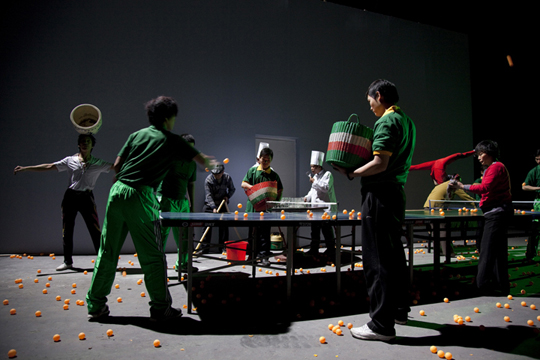
|
| WANG JIANWEI, Making do with Fakes (2011) |
|
